|
This section, the second page of the mini-FAQ,
examines how file sharing between Gameboy cartridges,
personal computers and the internet is
accomplished with GB KISS (cartridge <--> cartridge, cartridge
<--> PC <--> internet).
The
commercial success (or failure) of Hudson's GB KISS technology is
discussed, followed by a brief look into the Japanese and North American
catalog of GB KISS software (only one GB KISS game was released in North
America -- ROBOPON for Gameboy Color).
As always, if you are confused with any of the GB KISS concepts or lingo, consult the glossary of
GB KISS terms.
Nectaris fans take note : For your viewing pleasure, you will
find a Nectaris GB screenshot that might offer some clues as to what the
web-exclusive Nectaris GB download consisted of. I was a bit
surprised, myself.
|
| |
GB
KISS IN ACTION: internet
downloads & file sharing |
|
The GB KISS LINK infrared modem enabled gamers to download new, exclusive
content for Hudson's GB KISS games (i.e. Nectaris GB, Pocket
Bomberman ) and save it onto the Gameboy cartridge itself.
Here's how it worked... First, you would go to a Hudson webpage like
this one for Nectaris GB, download the exclusive content (i.e. extra
stages),
and save the files on your PC's harddrive. Then, by using a special
GB KISS utility program (installed on your Windows 95 PC) in conjunction with the GB KISS LINK modem, the game data
could be transferred from your PC and into any of the available memory slots on
your Nectaris GB cartridge (a maximum of six memory slots per
cartridge). Once you had the downloaded file on
your Gameboy cartridge, you could share it with your friends by
using GB KISS (more on this later).
|

|
|
|
 |
|
|
Hudson
offered exclusive content ( i.e. new stages ) to those
who owned GB KISS LINK. |
|
Unfortunately, the download
link on the aforementioned Hudson webpage (and reproduced above) has long been broken, although I am
ever hopeful that someone out there still has the file and will share
it with me. What did the "'GB KISS LINK DATA
DOWNLOAD" contain? Bonus stages for an action game? Extra
items / spells / weapons for an RPG?
|
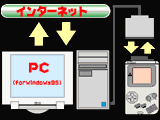 |
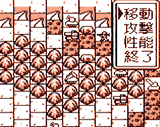 |
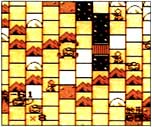 |
|
|
LEFT
: This diagram succinctly summarizes how exclusive videogame
content from the internet is transferred to a Gameboy cartridge
via GB KISS LINK and a PC running Windows 95. MIDDLE
: This screenshot shows a battle map from Nectaris GB -- but
the topography is comprised of new graphics that are markedly
different from those used in the normal Gameboy version
(screenshot on far right). |
|
For games like Pocket Bomberman and
Nectaris GB (which offer a level editor for constructing maps), I assumed that the downloads would
merely consist of "bonus stages". I was surprised, therefore,
when I saw the screenshot above (middle) from Nectaris GB :
the graphics for the battle map (but not the troops) have been
completely overhauled and given a facelift (compare the middle
screenshot with the one on the right for comparison). Of course, I
am speculating about this screenshot and its origins. I could be
mistaken, but how else
can the middle screenshot be explained? There is always the
possibility that the screenshot was a mock-up or prototype for something
that Hudson was considering to do, but later decided against. In
fact, this isn't
the first time that Hudson has teased Nectaris fans with mysterious
screenshots (more on this later). Personally, I find the graphics
in the middle screenshot much more appealing than those found in the
original Gameboy version, so I'm keeping my fingers crossed (the new
graphics are much cuter than the bland originals).
|
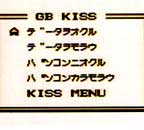
|

|
|
|
GB
KISS for Gameboy |
GB
KISS for PC ( Win 95 ) |
|
"GB KISS" is a term created by Hudson Soft, and yes, it implies that two Gameboy cartridges are "kissing" each
other -- but instead of exchanging saliva, they are exchanging data. "GB KISS" is a broad term that refers to "wireless, infrared file transfer."
Hudson had to develop a utility for managing and transferring
files; this utility was included on all GB KISS Gameboy cartridges
(see screenshot above, left). A similar utility was developed as
an application for Windows 95, thus allowing a PC to send and receive
Gameboy files via the GB KISS LINK modem (screenshot above,
right). Therefore, "GB KISS" refers to both PC
<--> Gameboy as well as Gameboy <--> Gameboy
file sharing. However, since the GB KISS LINK modem was owned by a
minority of gamers, the term "GB KISS" is most commonly used in reference to Gameboy
|
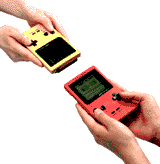 |
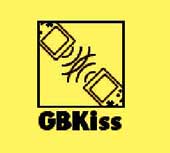 |
 |
|
|
GB
KISS demonstration |
Official
logo for GB KISS |
GB
KISS error message |
|
cartridge <--> cartridge file sharing, as depicted in the image above
(left), since this was the most common application of GB KISS technology (i.e. sharing user-created maps from
Pocket Bomberman or Nectaris GB ). Actually, the
picture above is inaccurate: in order for GB KISS to work, the
cartridges would have to be much
closer together (no more than one centimeter apart). Also, you
would want to lay the Gameboys on a flat surface to ensure that the IR
ports are parallel to each other. If you tried to send or receive
a file as depicted in the picture, you would get a cute error
message (image on far right) indicating that GB KISS is not working
properly. As I mentioned earlier, all GB KISS games included
this
|
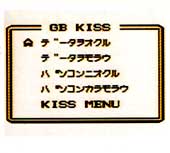 |
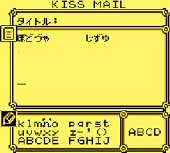 |
|
|
GB
KISS MAIN MENU |
GB
KISS MAIL : write & send notes |
|
utility for managing and transferring files (both game data
files and text message files). A screenshot of the main menu for
this utility is above (left). Each GB KISS cart allocated six memory slots for game data (i.e. save states, user-created maps, con- tent downloaded from internet) and 18 slots for text messages. Yes, that's right, with "GB KISS MAIL" you could compose text messages (both kana / kanji and Roman alphabet available). Then, with GB KISS, you could send
,and receive, messages to and from your
friends.
WHY
MOST FOLKS DID NOT NEED THE GB KISS LINK MODEM
: GB KISS enabled you to share game data and text messages with
fellow Gameboy owners via the cartridge's own IR port, so you didn't
need the GB KISS LINK modem for GB <--> GB interactivity (i.e. the
GB KISS LINK modem was strictly for PC <--> Gameboy
interactivity). Therefore, to play the special maps exclusive to
the Hudson website, you didn't necessarily need a GB KISS LINK modem or
a PC. All that you needed to do was find someone who had the file
on his or her cartridge already. Upon finding such a person, they
could easily send it to your Nectaris GB cartridge by using GB KISS
MAIL. Given this state of affairs, we have to ask ourselves if
there was a great demand for the modem hardware, since the website content (the primary
reason for purchasing the modem) could be obtained from other sources
(person-to-person). This topic is discussed in the next section...
For more information on GB KISS and the LINK modem, check out
the Nectaris GB instruction manual scans.
|
| |
GB
KISS & the LINK MODEM:
Success Or Failure? |
TOP
|
Determining the success of
GB KISS technology is not a simple task, since it depends on how we
define "success." Success from a technological
perspective? If GB KISS and the LINK modem performed their tasks
reliably and with minimum hassle, then I would definitely consider GB
KISS to be a success. Hudson demonstrated that innovative features
(i.e. wireless file sharing) could be integrated into Gameboy software
and be compatible with ALL Gameboy models (Gameboy Color was released 9
months after GB KISS, and in order to use the IR features of GB Color
software, you had to own GB Color). Furthermore, Hudson
demonstrated that "bonus" game content for Gameboy games could
be distributed via the internet. For Gameboy, a handheld from
1989, to have these features in 1998 is impressive (remember, GB KISS
was developed around the original Gameboy design). From a purely
technological standpoint, Hudson's GB KISS was a
success. But were GB KISS features successful in the gaming
world? This is difficult to determine. How often did folks
use GB KISS to share files? Was there a real incentive to use GB
KISS (i.e. obtaining new, quality content) or was it more of a
gimmick? Was it convenient to use or a hassle? It is clear
that IR file sharing, in general, never became wildly popular in the
gaming world (i.e. popular to the point where most software incorporated IR features,
something which did happen, for example, with "rumble packs" and
"shock controllers" on software for home consoles).
|
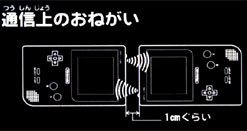 |
|
Was GB KISS successful as a
commercial product? I don't know how well GB KISS software sold,
and I can't determine if the GB KISS features were the impetus behind
any of the sales. I think it is safe to say that GB KISS LINK was
always intended to be a niche product, so I doubt Hudson was expecting
to make much money from it. GB KISS LINK was not sold in stores, it was only available via mail
order. In case you were wondering, the modem was not sold directly
from Hudson Soft's website, but through ASCII's site ( http://www.ascii.co.jp
), although the URL to the Hudson Online Store is now defunct ( http://www.arcs.ne.jp/direct_store/hudson/main.asp
). ASCII is a large media publisher in Japan (focusing on computer
& technology magazines) and published the Nectaris
Official Guide Book to accompany the 1998 PlayStation update of
Nectaris. It is possible that ASCII's site, in addition to selling
the GB KISS LINK modem, mirrored content from Hudson's website (i.e.
perhaps ASCII's site mirrored the "GB KISS LINK DATA
DOWNLOADS" that were available on Hudson's site, like
this one for Nectaris GB ). Regardless, the ASCII site is
prominently mentioned on the front
side as well as the back
side
of an insert that was included with all GB KISS software.
|
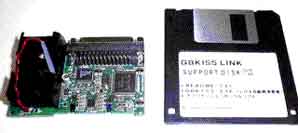
|
|
GB KISS LINK sold for 4,980 yen (approximately $45 USD), which was
actually more expensive than most of the Gameboy games it was compatible
with (i.e. Nectaris GB retailed for 4200 yen, approximately $38
USD; Pocket Bomberman another GB KISS compatible game, sold for
3,980 yen, roughly $36 USD ). It would be interesting to find out how
many GB KISS LINK's were manufactured -- and of those, how many were
actually sold -- because the appeal of a niche peripheral like GB KISS
LINK is limited, almost exclusively I think, to hardcore fans of
particular Hudson series. Then again, to get this exclusive
download, you didn't necessarily need to own a modem -- you simply had
to find someone who would share the file with you. Also, unlike
cell-phone gaming, Hudson did not charge for the "GB KISS LINK DATA
DOWNLOAD". All of this suggests that Hudson was not expecting
to profit massively from modem sales. At worst, it suggests that Hudson
was using GB KISS LINK as a "gimmick" to stimulate interest in
its software. At best it was a novelty that appealed to primarily
to hardcore fans who were completists and had to have the
"bonus stages".
|
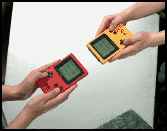
|
|
Then again, Hudson probably would not have expended the time, resources,
and money to develop GB KISS if it doubted the size and loyalty of the
fan base for its' games (for example, the Bomberman fan base).
There were other popular Hudson titles as well, but I know for certain
that Bomberman was huge at one time...though by 1998 the craze may have
lost most of its steam (in no small part due to Hudson's incessant
recycling of the series). As I mentioned in the introduction, I
think Hudson was pushing hard to rekindle interest in its Nectaris
franchise during first quarter of 1998: two new software titles
were released (on PlayStation & Gameboy), GB KISS LINK hardware was
released (compatible with Nectaris GB), and a dedicated Hudson website (with Nectaris GB
downloads) was launched to support GB KISS LINK modem <--> Nectaris GB
interactivity. With this in mind, I cannot help but wonder how
things went for Hudson. Were the Gameboy and PlayStation Nectaris
titles successful in Japan? Was the GB KISS LINK modem successful
as a niche product? Did Hudson provide sufficient support for the
modem? What downloads were available, and for what
games?
Did I mention that a FREEWARE version of Nectaris (PC Windows 95
/ 98) was released in Japan in November of 1997? This PC port was
faithful to the original PC-Engine Nectaris, although it did add
a map editor. Were the maps created with this PC freeware compatible
with the GB KISS LINK or Nectaris GB?
As you can see, there are innumerable unanswered questions surrounding
GB KISS and the LINK modem. I have already listed several of them, but
here are additional points that also need to be addressed in future
updates of this mini-FAQ...
|

|
ASPECTS OF GB KISS THAT NEED TO BE
CLARIFIED : ( 1 ) What were all the features of GB KISS?
For example, how is the telephone being used in this
picture and this
picture -- is GB a speed dialer (or is it dialing into a
service)?
( 2 ) I would expect you would have the ability to make back-up
copies of cartridge data by saving these files on the PC, but I cannot
verify this. Also, it might have been possible to upload game data from
one's PC to the Hudson website--as the diagram above appears
to indicate--and thus share the maps you created with fellow
Nectaris GB fans via the internet, but again, I have no way of
confirming this. Perhaps files could be shared via
email? ( 3 ) Were there 29 pack-in mini-games for GB
KISS LINK? Did all 29 games fit in one memory slot on a Gameboy
cartridge?
Contact me if you can shed
light on any of these issues! |
|
Nectaris GB was the first of several
Japanese Gameboy games to support GB KISS LINK and GB KISS MAIL.
The GB KISS features were exclusive to Hudson Soft, so if you wanted to
compile a list of all the GB KISS compatible games, you would only have
to search through Hudson's Gameboy & Gameboy Color back
catalog. I have yet to do this research, but I can tell you that Dai Kailuu Monogatari: The Miracle of the Zone
(1998, and possibly its' sequel on GBC the following year) supports
GB KISS. Dai Kailuu Monogatari was a card battle game
(surprise!), so I assume GB KISS
|
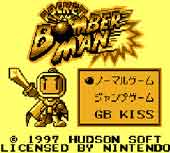
|
|
|
GB KISS features were stripped
from the US version of Pocket Bomberman. |
|
is harnessed to trade cards with fellow
gamers. Pocket Bomberman (1997) features a stage editor
(i.e. construction mode) for designing your own levels, so I assume GB
KISS allowed you to share your creations with fellow Bomberman fanatics,
including exclusive downloads from Hudson's website (much like Nectaris
GB). The Hudson website suggests that Nectaris GB was the
first software title to support GB KISS LINK...and yet the older Pocket
Bomberman already has GB KISS compatibility (...but perhaps it cannot
download new content from the internet?). Can anyone verify this? if so,
contact me
. The GB KISS story gets even more bizarre, though, as we examine
one final item ...
| |
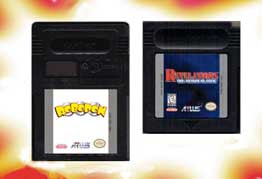 |
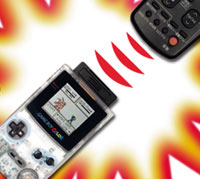 |
|
|
LEFT
: The larger Robopon GB KISS cart compared to a standard Gameboy
cart. RIGHT : During gameplay, remote controls from
common household electronics interact with Robopon's IR port. |
|
Robopon (1998, Gameboy Color, Hudson Soft, Published by ATLUS in North America) was the first and only GB KISS
game released in North America. However, it was not a standard GB KISS
cartridge: it had a built-in speaker and battery- powered clock (in
addition to the built-in IR port, of course). As the image on the
left reveals, the Robopon GB KISS cartridge was much larger than a standard-sized Gameboy cart.
It is safe to assume that the speaker assembly (plus amplifier) and the
user-changeable battery account for the bulkier size of Robopon, since
the standard GB KISS cartridge is physically identical to normal Gameboy
carts. Anyway, Robopon offered the usual file sharing capabilities
(i.e. sharing game data with friends. In fact, here is a
webpage from Hudson's website about this). But that is not all
it can do ...
Look closely at the image on the right -- those are not two Gameboys
kissing each other -- but rather a remote control (infrared) from a common household electronic device interacting with Robopon's IR
port (here's a webpage from Hudson's website discussing
the remote control feature). At certain points during the
game, it was necessary to send IR waves to Robopon (i.e. to open up a
treasure chest) ... This was accomplished by aiming various remote
controls at Robopon's IR port and pressing buttons at whim. I
guess this was an attempt to innovate gameplay (by making the game more
inter- active, and by making the effects of this interaction
unpredictable). Similar concepts have been used in other games...
one of these days I'll tell you about 1993's CD BATTLE - HIKARI NO YUUSHATACHI
(CD BATTLE - Heroes of the Light) for the PC-Engine DUO, an
arena-based battle game that requires players to insert different CD's
into their console to determine characters' abilities (results vary
depending upon the CD).
|
|